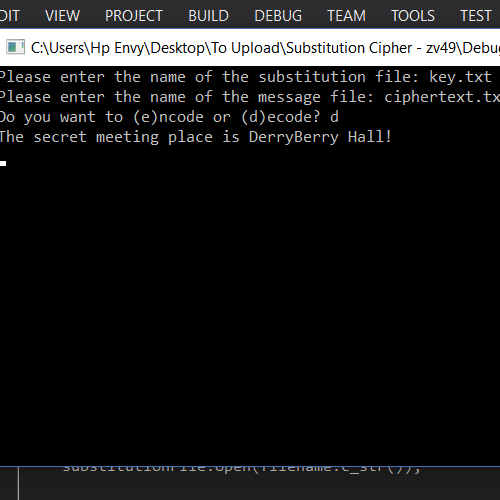
- Substitution cipher solver cracked#
- Substitution cipher solver code#
- Substitution cipher solver series#
Substitution cipher solver code#
Although our current implementation of the Playfair solver may not be entirely practical, due to its long run-time, we were able to build a working solver without an excessive amount of redundant code further performance optimizations may lead to a more efficient and effective Playfair cipher solver. In order to increase performance on this front, we decided to use HashMap instead – this allowed us to perform single look-ups in constant time. Our first implementation of this data structure was done using Map, which performs on the order of O( lg n) for a single lookup. The algorithm we utilized involved frequent look-ups to obtain the scores corresponding to certain sub-strings. We hypothesize that this may be one of the factors contributing to the sub-optimal run times associated with our Playfair solving algorithm. In comparison to other languages, such as Java, Haskell's use of IO in generating random numbers may have performance consequences in cases where large amounts of random numbers are being generated. We learned about Haskell's implementation of random numbers, and how it is interconnected with IO. With regards to the encoding and decoding portions of this project, we found that Haskell allowed us to manipulate various data structures with relative ease and with fewer lines of code features such as list comprehension were especially useful. This will likely involve the use of machine learning strategies such as hill-climbing and simulated annealing. In addition to providing a Playfair cipher encoder and decoder, we also plan on implementing a Playfair solver to break a given piece of ciphertext without knowing the key. Our program will also be able to decode a given piece of ciphertext when provided with the correct keyword.

A detailed description of the encryption process can be found here.įor this project, we will implement a Haskell program that will allow the user to encode a given piece of plaintext using the Playfair cipher. The Playfair cipher uses a keyword or phrase contained within a 5 by 5 table of characters to encode a given piece of plaintext. It is significantly harder to break when compared to simpler substitution ciphers such as the Caesar cipher or the Vigenère cipher, since common cryptanalysis methods such as frequency analysis are not easily applicable. The Playfair cipher is an encryption technique popularly known as the first practical digraph substitution cipher. Gronsfeld ciphers, and variants of it, are frequently used in CTFs, geocaching mystery caches, and logic puzzles.Ĭode-breaking is not only fun, but also a very good exercise for your brain and cognitive skills.Playfair Cipher Solver Authors: Alyssa Zhao, Seiyoung Ahn What is the problem?
Substitution cipher solver cracked#
It has more limited key strength than Vigenère cipher, because the shift only be between 0-9, so unless the key is long it can be cracked by brute force methods.
Substitution cipher solver series#

Note: Auto Solve will try in the mode you select (Standard Mode or Autokey mode). In case a specific letter (for instance X) is used as word separator, set it to Substitute. In most cases it should be set to Automatic.

Spacing Mode: This is about the spaces (word breaks) in the text.Max Results: This is the maximum number of results you will get from auto solving.Iterations: The more iterations, the more time will be spent when auto solving a cipher.Min/Max Key Length: This is the search range for keys when auto solving a cipher.Language: The language determines the letters and statistics used for decoding, encoding and auto solving.It eliminates the periodic repeats otherwise seen in polyalphabetic ciphers. Standard Mode v s Autokey Variant: The Autokey mode is a stronger variant of the cipher, where letters of the plaintext become part of the key.If you don't have any key, you can try to auto solve (break) your cipher. You can decode (decrypt) or encode (encrypt) your message with your key.


 0 kommentar(er)
0 kommentar(er)
